This post may contain affiliate sales links. Please read my disclosure policy.
Let’s talk about how to make a water bath for a cheesecake! They aren’t hard to set up and the extra step will give you a beautiful, creamy cheesecake free of cracks! Plus, I’ll share with you my tricks for no leaks!
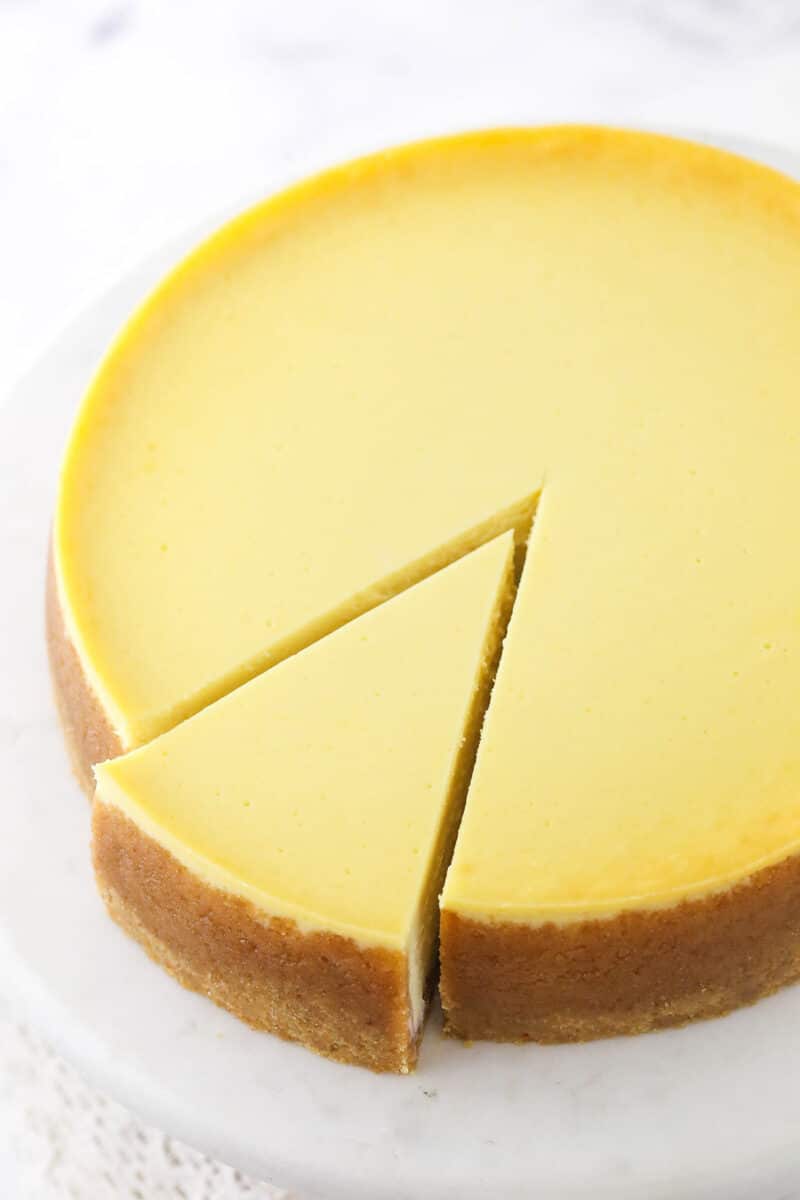
There’s no doubt that I’m a huge fan of cheesecake. The sheer number of cheesecake recipes on my site gives me away. I love the classics and I love unique twists. And with all the cheesecake baking I’ve done over the years, I’ve learned a lot and my number one tip for success is a water bath. If you want a beautiful cheesecake free of cracks, over-browned edges and a sunken middle, you need to use a water bath.
What is a Water Bath?
Cheesecake is basically a custard-based dessert and therefore needs to be treated differently. A water bath, also known as a bain marie, is our secret to the perfect cheesecake. It produces steam that wafts throughout the oven, helping to ensure that the cheesecake cooks evenly and stays nice and creamy. It also moderates the heat on the sides of the pan so that they edges don’t cook much faster than the center.
Why Use a Water Bath?
The benefits of a water bath are plenty. It gives you a cheesecake that:
- Is free of cracks.
- Doesn’t over cook or over brown on the edges.
- Doesn’t sink in the middle while cooking.
- Stays super smooth and creamy.
However, water baths can often be confusing, leak and generally be a pain. So I’m excited to share my methods with you today because they aren’t complicated, won’t leak and it is SO much better than not using a water bath. You spend so much time making a cheesecake – don’t skip this final step and end up with an underwhelming result.
What You’ll Need
I’m going to share a few ways of setting up a water bath. You have options! The first requires the least amount of equipment, but is most likely to leak. The other two will keep you leak-free and really depend on preference. Here’s what equipment you’ll need.
- Springform Pan: You’ll need a 9 inch springform pan for most recipes.
- Large Pan: “Large” is a little vague, but ultimately you need a pan larger than the springform pan that the water will actually go in. It can be a large roasting pan or a large cake pan (I use a 12 inch cake pan).
- Aluminum Foil: This is optional depending on the method you choose. I recommend to long, heavy duty foil.
- Slow Cooker Bags: These are optional depending on the method you choose, but can help prevent your water bath from leaking.
- Large Silicone Pan: This is also optional depending on the method you choose, but it is the easiest method and most likely to prevent leaking. You have to buy the pan, but if you bake a lot of cheesecakes, it will totally be worth it.
- Hot Water: To fill your larger pan.
How to Set Up A Water Bath
Setting up the water bath is a few step process. The wrapping of the pan happens after you bake the crust and adding the hot water happens just before you bake it.
- Make your crust: The first thing you need to do for any cheesecake is properly prep your pan and add your crust. I typically use a graham cracker crust or Oreo crust. I typically pre-bake my crust a bit.
- Prep your pan for the water bath: After you bake your crust, you can go ahead and prep your pan for a water bath using one of the 3 methods below. After prepping the springform pan, place your springform pan into the larger roasting pan or cake pan.
- Add cheesecake filling: Now you can make your cheesecake filling and add it to the crust.
- Add hot water: Bring your pan close to the oven so prevent moving a pan full of water all over the place, then add the hot water to the outer large pan.
- Bake cheesecake: Place your cheesecake and it’s water bath in the oven and bake as directed.
- Cool Cheesecake: When your cheesecake has baked, you can remove it from the water bath, but leave it in the springform pan. You can set the cheesecake on a cooling rack to cool to room temperature and then refrigerate it, or just place it straight in the fridge to cool completely. If you don’t want any condensation forming on top, let it cool to room temperature before refrigerating it.
Three Water Bath Methods
Method 1: Aluminum Foil
For this method, you’ll use aluminum foil around the outside of your springform pan. I’d recommend two or three layers to try to prevent leaking. You also don’t want to crinkle the foil too much at the bottom. It can cause little cracks to form in the foil, which can cause leaking. Leave it a touch looser around the bottom.
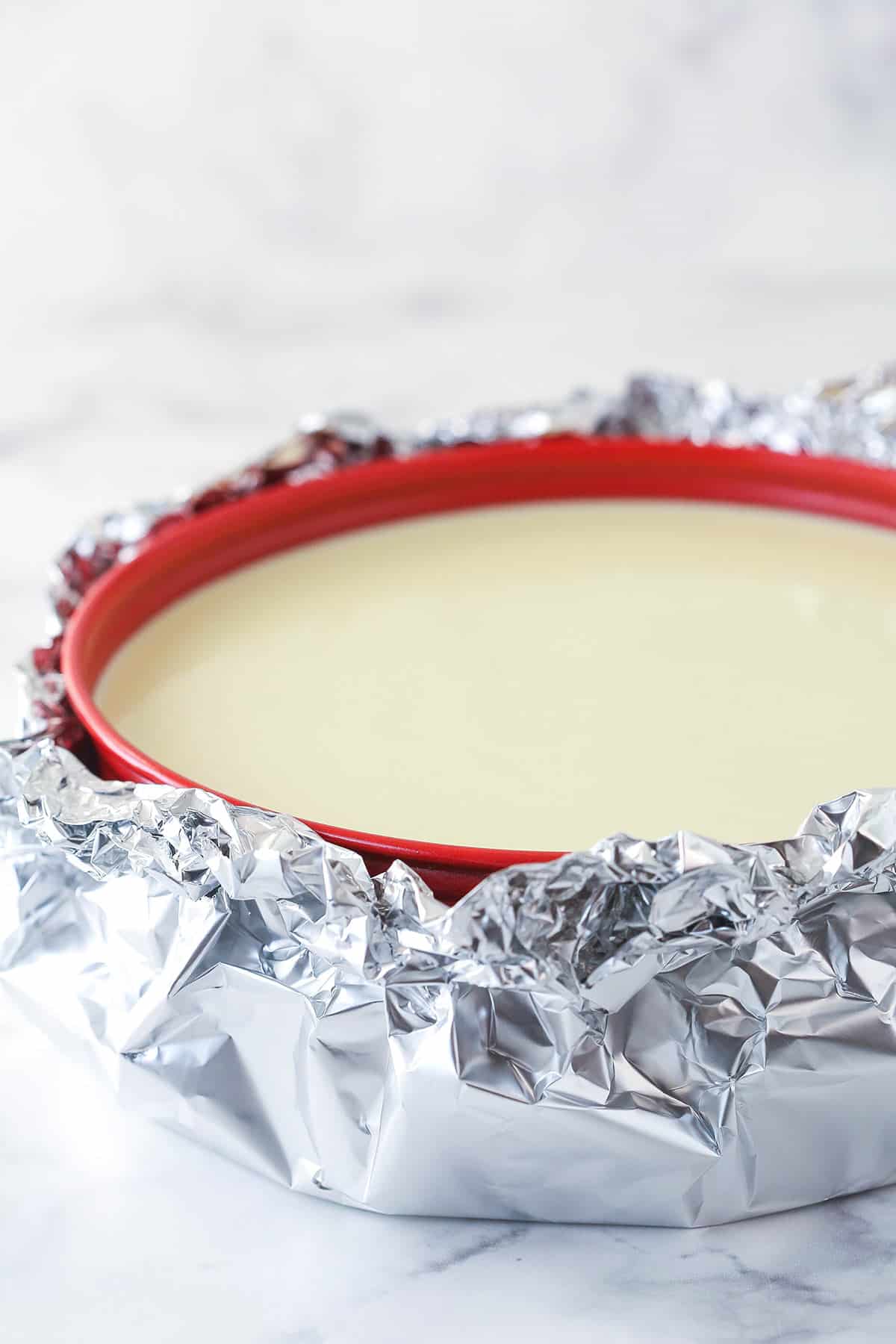
Set your foil-wrapped pan in your larger pan and fill the larger pan with hot water that comes about half way up the side of the springform pan. The water can boil a touch during baking, so you don’t want it to come up too high or the water could “jump” over the foil. Finally, bake your cheesecake according to your recipe.
Method 2: Slow Cooker Bags
I have been using this method for a long time. It was my original method for a leak-proof water bath and I’ve been doing this for years. Slow cooker bags can hold up to the heat and won’t form little holes or cracks, like aluminum foil. For this method, first wrap your springform pan in the slow cooker bag. The bag will be a little big, so tie a knot with the excess.
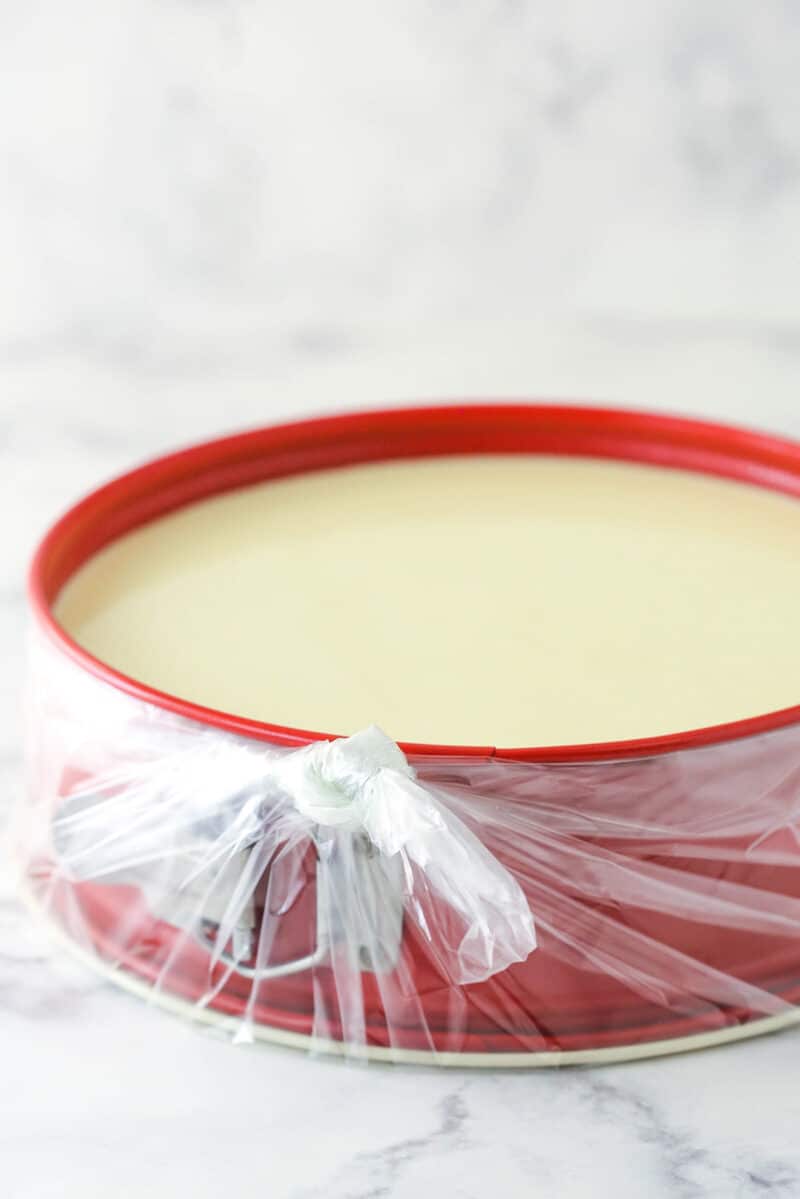
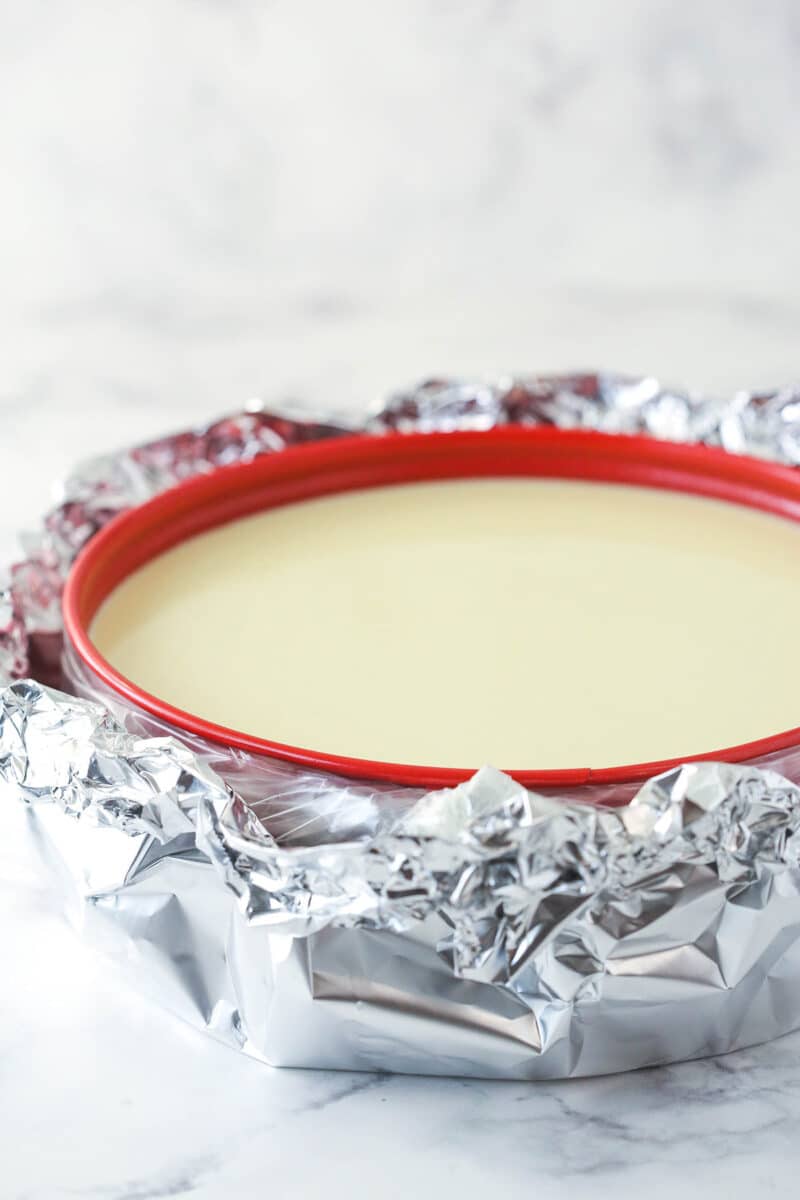
Wrap a layer of foil around the outside of the slow cooker bag, then place the pan in the larger pan. Fill the larger pan with hot water that comes about half way up the side of the springform pan, then bake your cheesecake.
Method 3: Silicone Pan
This is my most recent method. After getting a lot of questions about using a silicone pan in place of the slow cooker bag and foil, I decided to try it. I totally fell in love with this method! No need for wrapping and unwrapping, and no need to worry about leaking. Another plus is that the silicone pan is reusable so you won’t have to buy foil and bags over and over.
So for this method, just set your springform pan in the silicone pan. Place that into the larger pan that will hold the water, then add your hot water and bake. Just keep in mind that the water should only be about halfway up the sides of the silicone pan. You don’t want it to come up too high. The water could boil a touch while baking and you don’t want it to “jump” over the sides of the silicone pan and get into your crust.
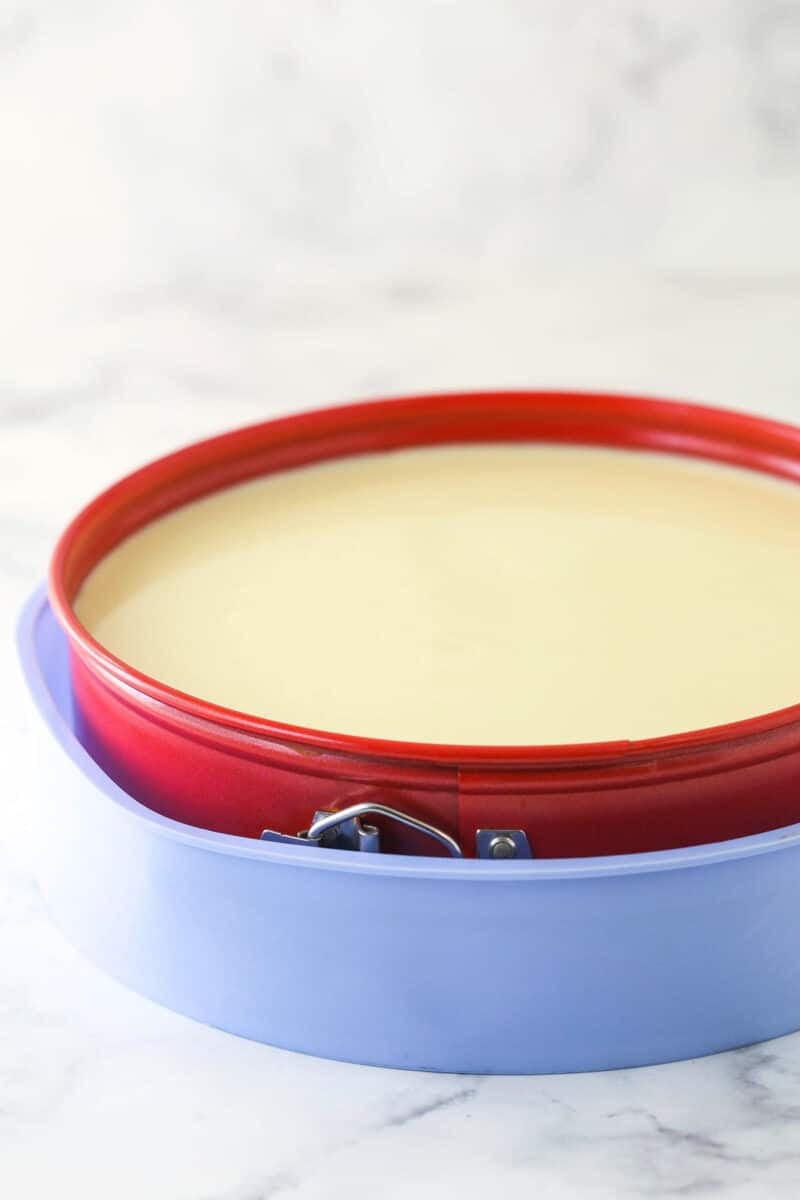
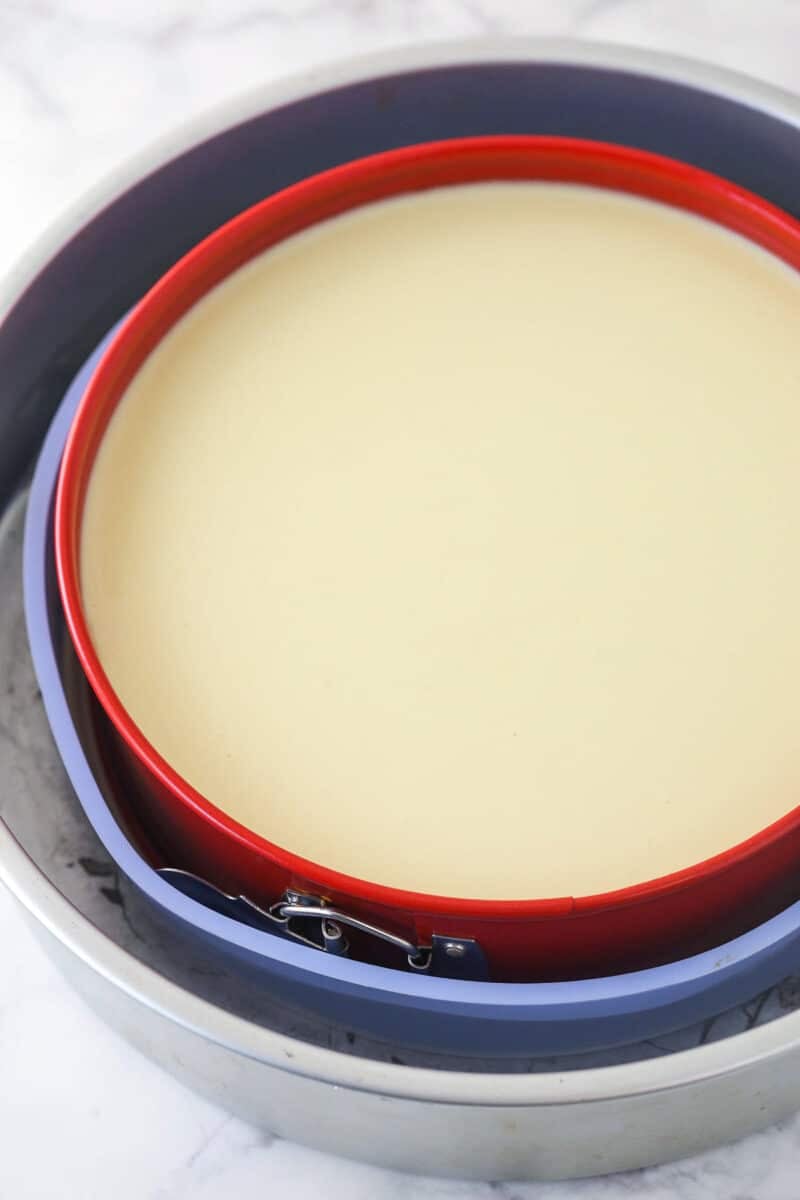
Compare: Cheesecake Baked With and Without a Water Bath
I’ve told you what happens when you bake a cheesecake without a water bath, and showed you how to set one up. Now let’s look at the final result with and without a water bath. Results could vary a bit between recipes (I used my Classic Vanilla Cheesecake), but this is generally what the difference looks like.
Cheesecake Baked with Water Bath
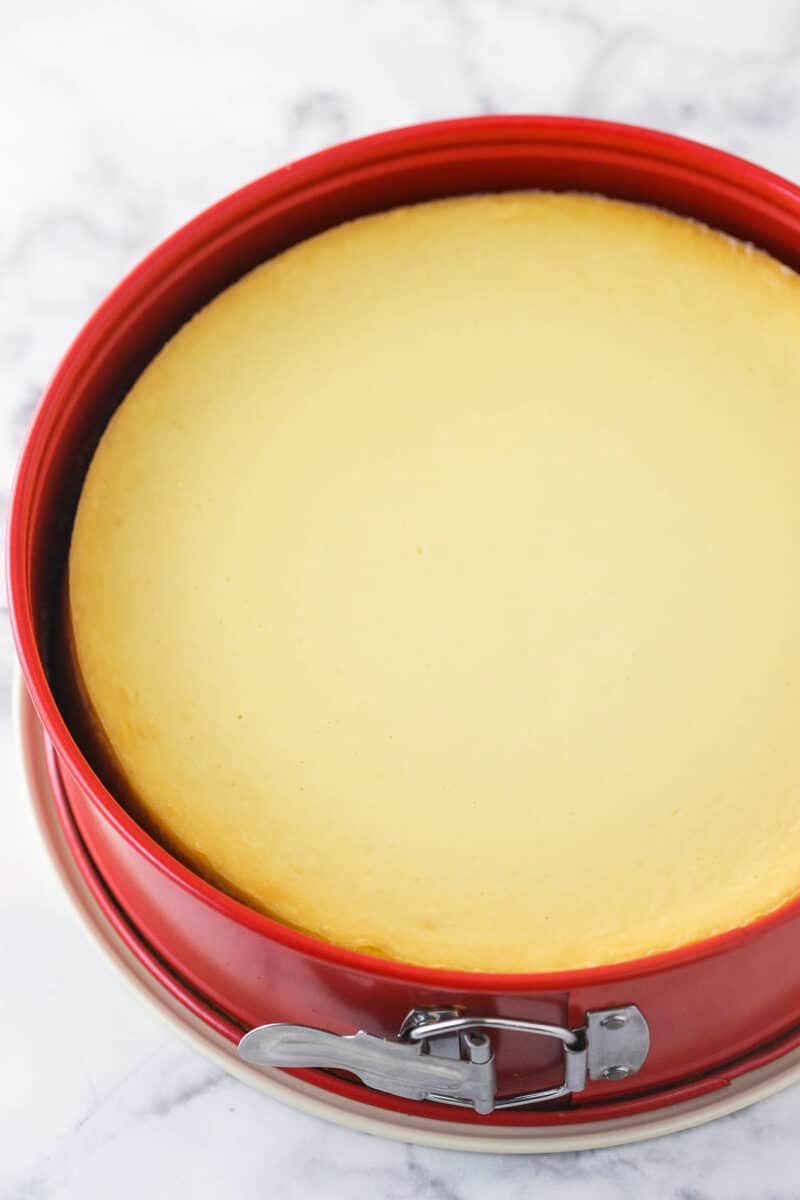
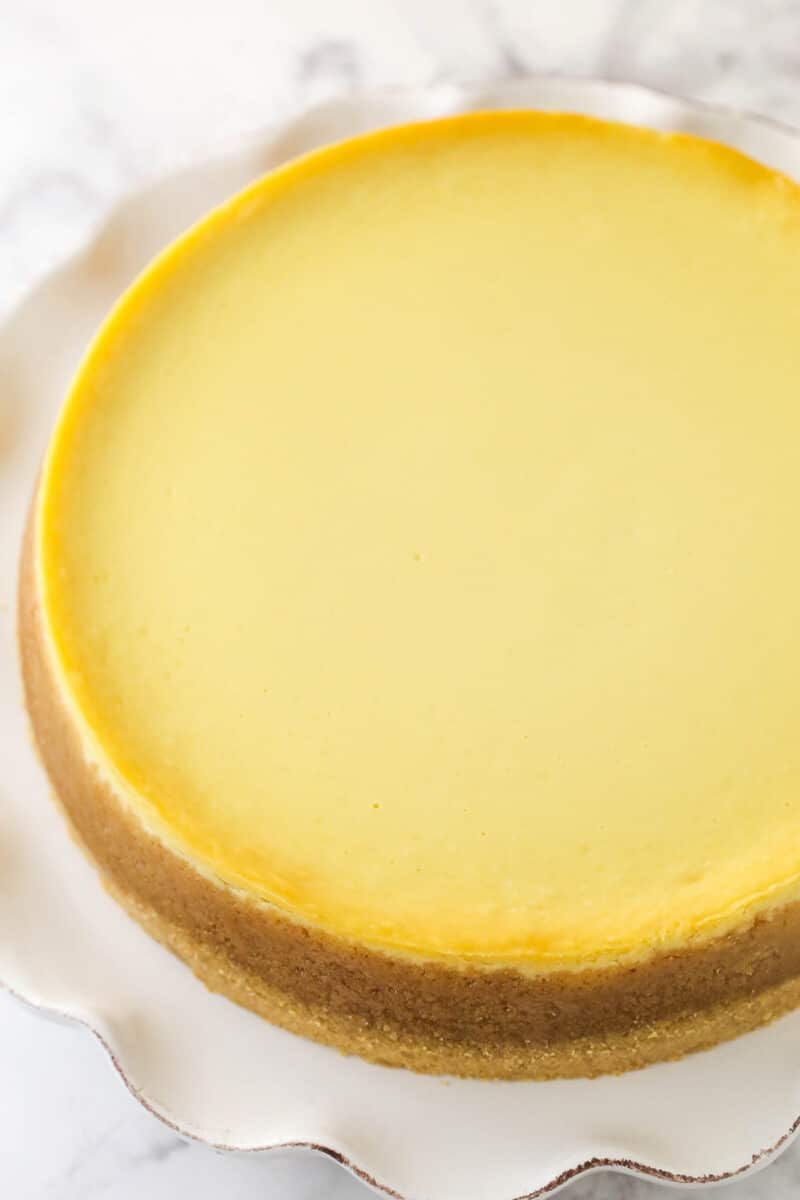
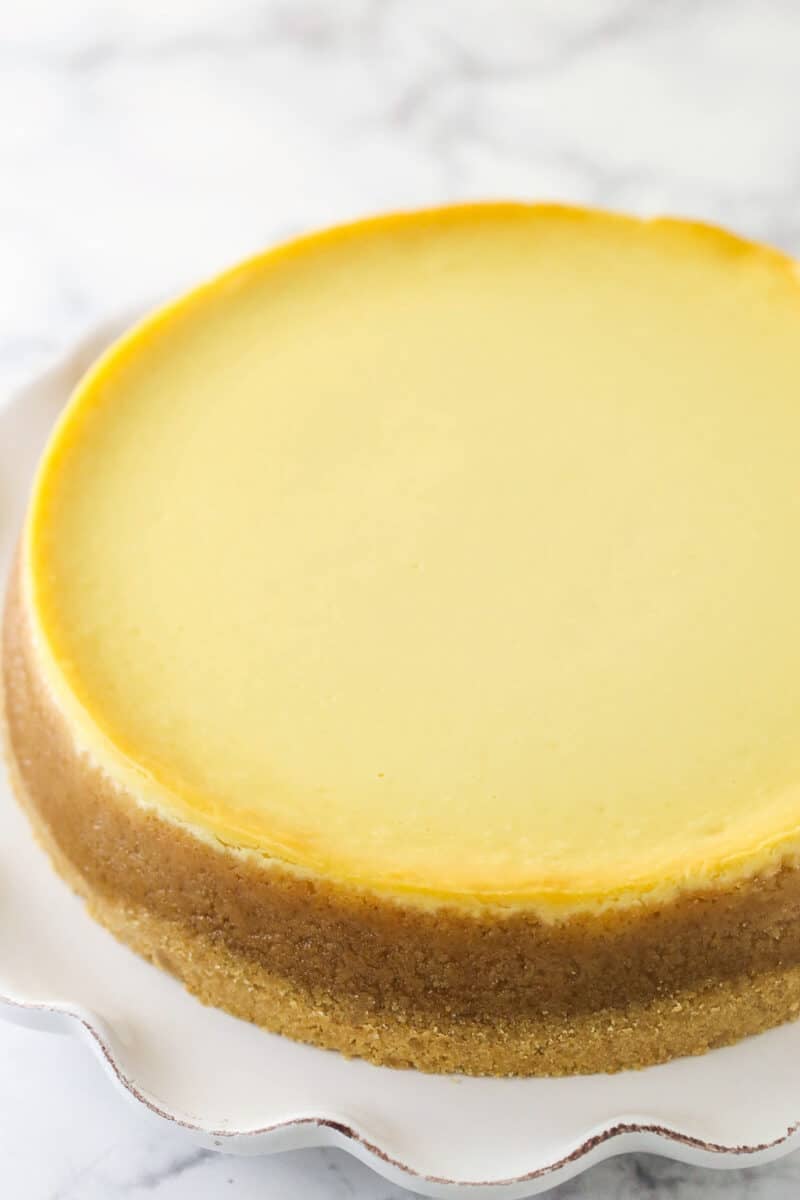
Cheesecake Baked Without Water Bath
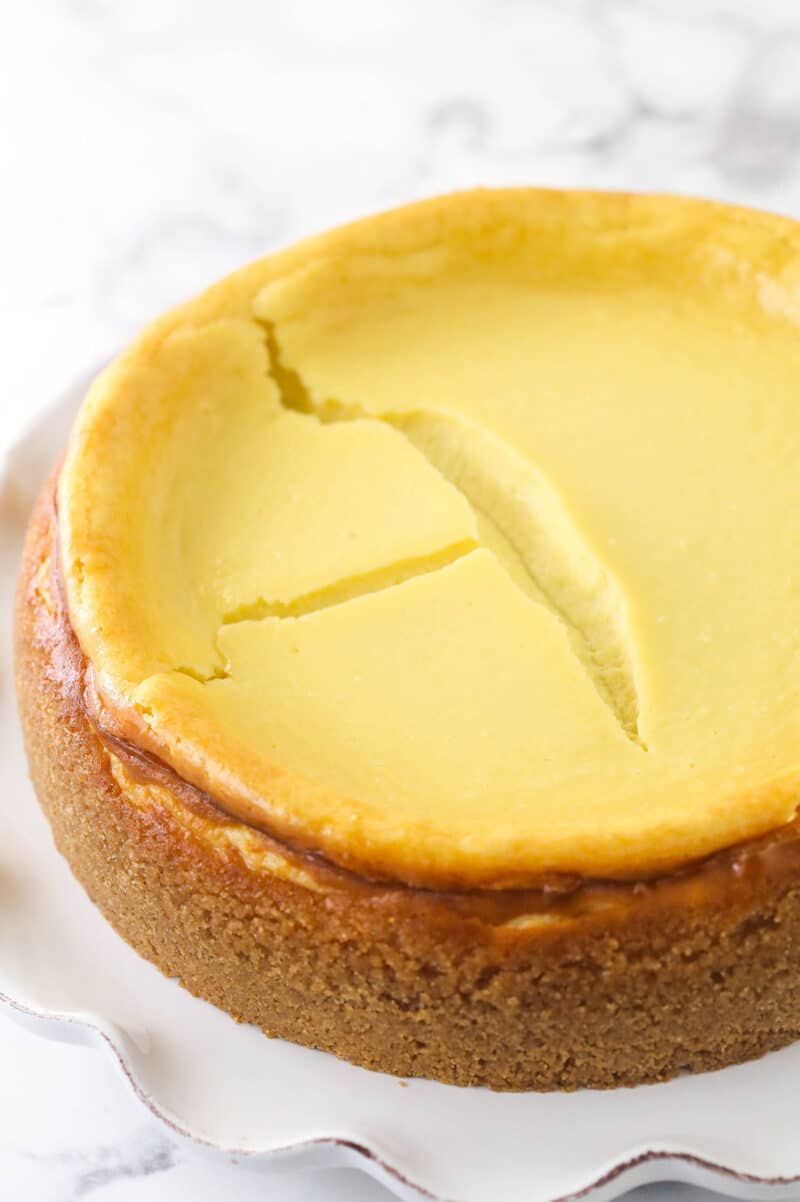
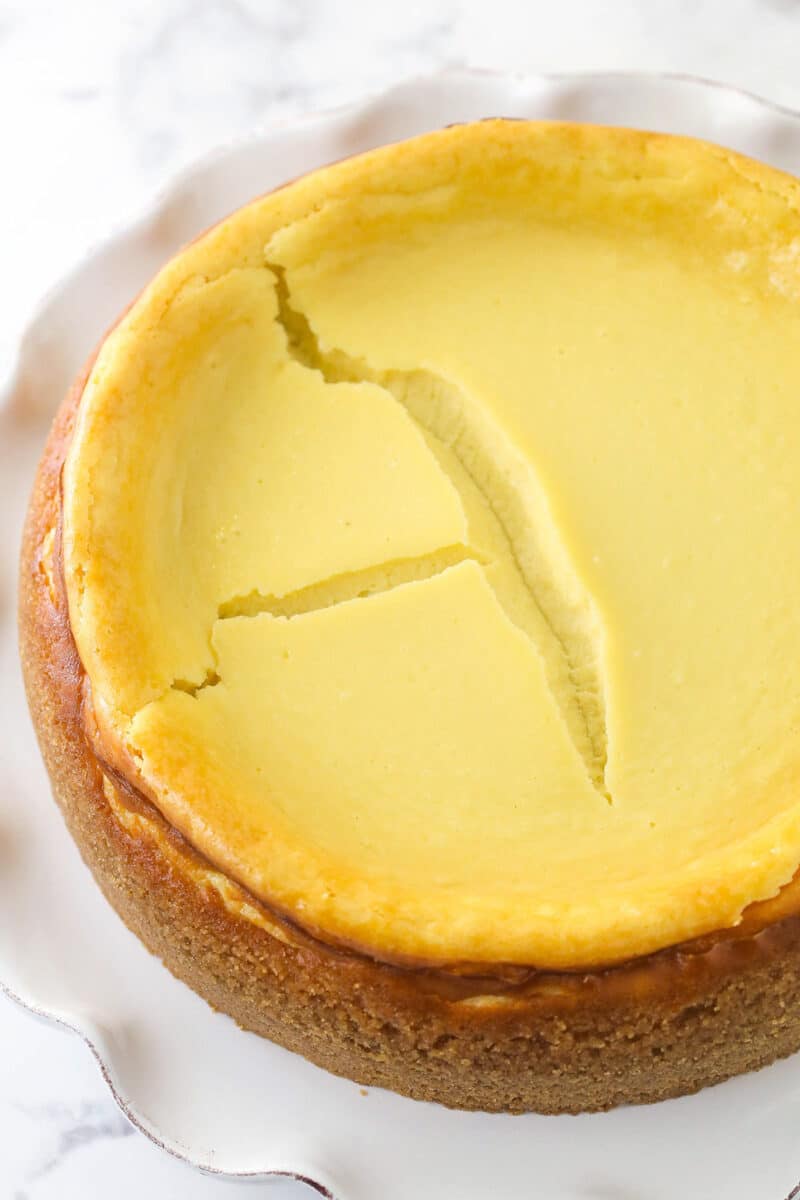
Can I Just Put A Pan Of Water On The Rack Below?
I get this question quite a lot, so I tested it. While your results may vary depending on the recipe, I found that the result was kind of in the middle. It still browned a little more than when you use a water bath and still fell a bit, which you can see in the sides, but otherwise it did well. It didn’t fall in the center and it didn’t crack. So if you’re really averse to using a water bath and don’t mind the slight imperfections, this would certainly be an option.
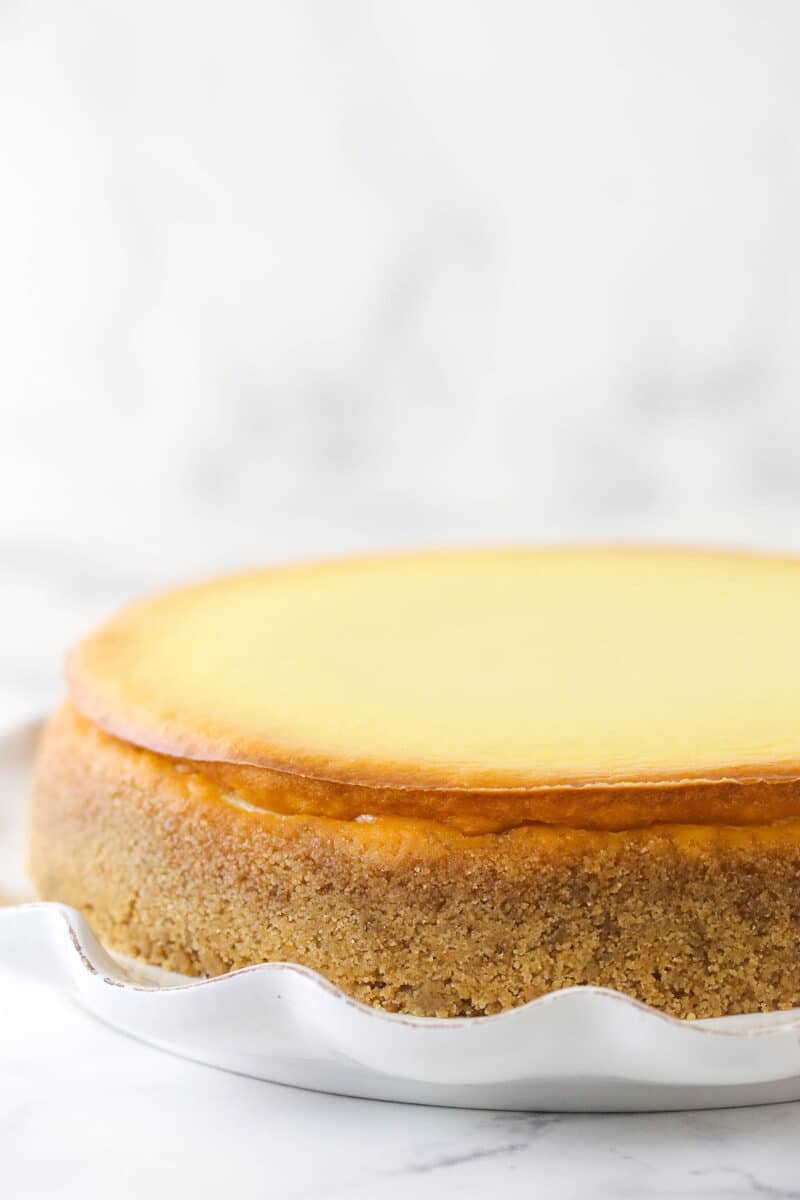
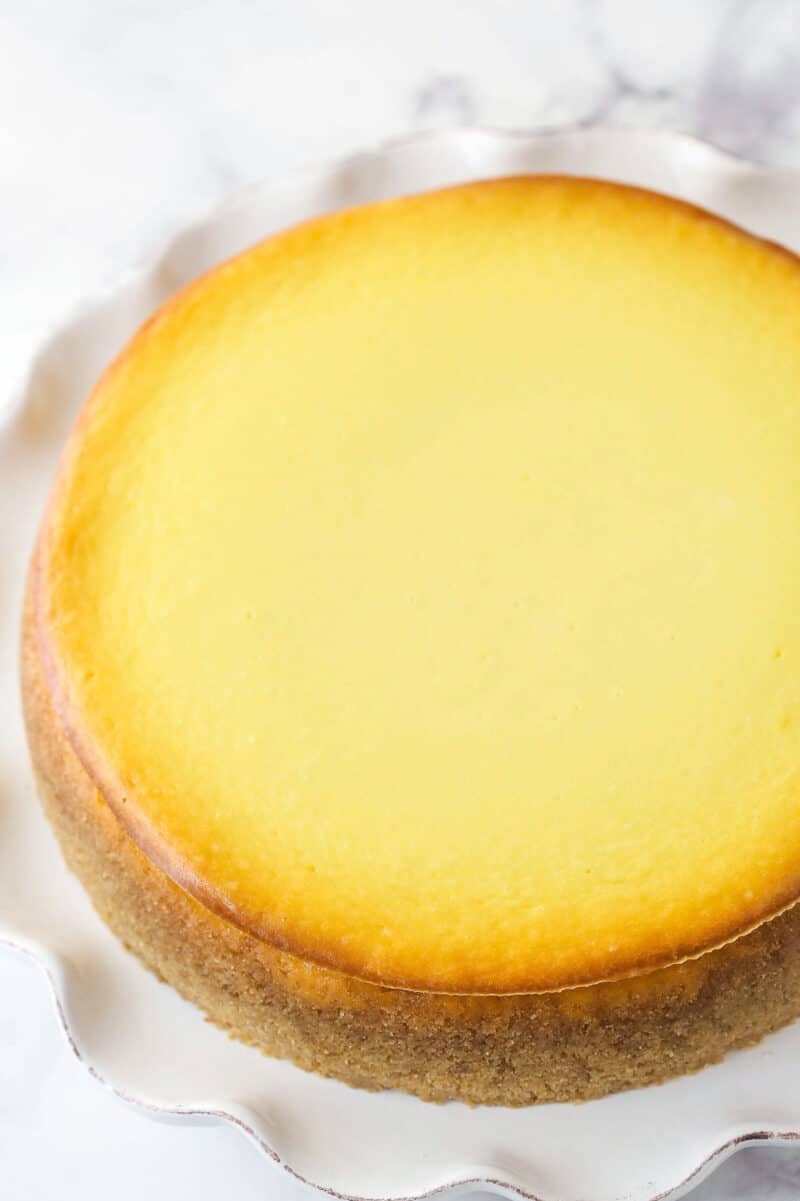
When do I NOT Need a Water Bath?
If you’re using a recipe that doesn’t call for one, then that should be fine. Mini cheesecakes also don’t require a water bath, nor do 9×13 cheesecakes. Their smaller and thinner size means they bake more evenly without having to use a water bath. And of course a no-bake cheesecake doesn’t need one either.
Pro Tips For a Great Cheesecake
- Don’t over or under bake your cheesecake. Check out my post on how to tell when your cheesecake is done baking.
- Add the water to your water bath pan with the pan near the oven. Trying to carry a heavy pan full of water and a cheesecake without it splashing around is not easy.
- Cool it slowly. All of my cheesecake recipes call for a two step cooling method that allows the cheesecake to bake fully while not over baking. It also helps to avoid cracking.
- Let your cheesecake chill and firm up before removing it from the springform pan. When you’re ready, check out my tutorial and video for how to remove a cheesecake from the springform pan.
- When you’re ready to store your cheesecake, check out my post on storing it, freezing it, etc.
- If you want to bake a cheesecake in a size other than a 9 inch pan, check out my guide to adjusting cheesecake sizes.
Now that you know how to do a cheesecake water bath, here are some amazing cheesecake recipes to try:
- Strawberry Cheesecake
- Best Oreo Cheesecake
- New York Style Cheesecake
- Dark Chocolate Cheesecake
- Turtle Cheesecake
- Cinnamon Roll Cheesecake
- Amaretto Cheesecake
- S’mores Cheesecake
- Mint Oreo Cheesecake
- Apple Cinnamon Cheesecake
- German Chocolate Cheesecake
- Red Velvet Cheesecake
- Caramel Apple Cheesecake
- Pumpkin Cheesecake
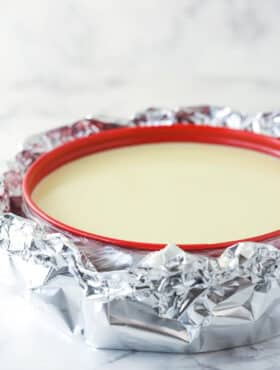
How to Bake Cheesecake in a Water Bath
- Prep Time: 45 minutes
- Cooling Time: 4 hours
- Cook Time: 2 hours 15 minutes
- Total Time: 7 hours
- Yield: 12-14 slices
- Category: Dessert
- Method: Oven
- Cuisine: American
Description
Let’s talk about how to make a water bath for a cheesecake! They aren’t hard to set up and the extra step will give you a beautiful, creamy cheesecake free of cracks! Plus, I’ll share with you my tricks for no leaks!
Ingredients
- Springform pan
- Aluminum foil, optional depending on method
- Slow cooker bags, optional depending on method
- Large silicone pan, optional depending on method
- Large pan (Like a roasting pan or a 12 inch cake pan)
Instructions
- Make your crust: The first thing you need to do for any cheesecake is properly prep your pan and add your crust. I typically use a graham cracker crust or Oreo crust. I typically pre-bake my crust a bit.
- Prep your pan for the water bath: After you bake your crust, you can go ahead and prep your pan for a water bath using one of the 3 methods discussed above. You can either: 1. Wrap your pan in two or three layers of aluminum foil, 2. Wrap you pan in a slow cooker bag and one layer of foil, or 3. Place your springform pan in a slightly larger silicone pan. Place your springform pan into the larger roasting pan or cake pan.
- Add cheesecake filling: Now you can make your cheesecake filling and add it to the crust.
- Add hot water: Bring your pan close to the oven so prevent moving a pan full of water all over the place, then add the hot water to the outer large pan.
- Bake cheesecake: Place your cheesecake and it’s water bath in the oven and bake as directed.
- Cool Cheesecake: When your cheesecake has baked, you can remove it from the water bath, but leave it in the springform pan. You can set the cheesecake on a cooling rack to cool to room temperature and then refrigerate it, or just place it straight in the fridge to cool completely. If you don’t want any condensation forming on top, let it cool to room temperature before refrigerating it.

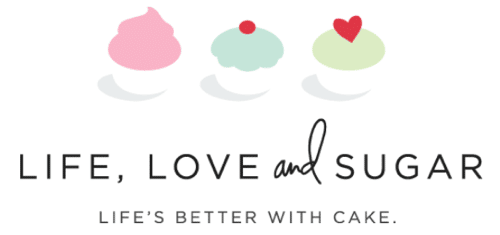
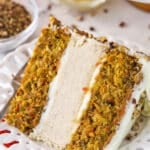
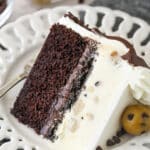

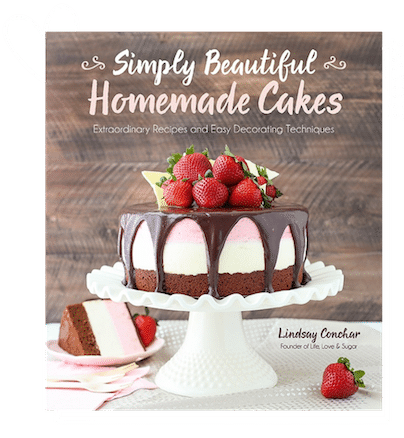
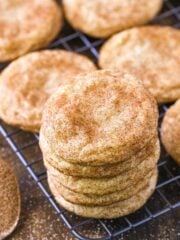
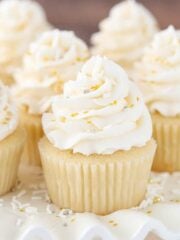
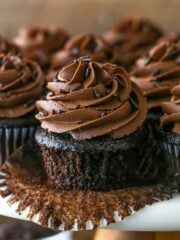

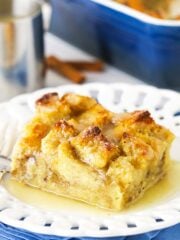
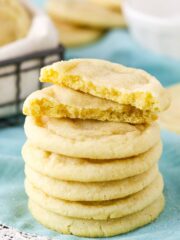
. My question is how do you take the bottom off and the parchment paper as well to put on another plate.
I made some cheesecake using the slow cooker bags, but was still finding a bit of moisture getting in. This time I lined the inside bottom of the bag with some paper towels and baked as usual. The paper towels soaked up the slight amount of moisture (enough to resemble a baby wipe) and the crust turned out amazing!
Made my first cheesecake yesterday. Wrapped the pan in foil. Everything was perfect, except the foil leaked. Went looking for an answer and found this! Perfect! Thank you!
I’m sorry your pan leaked, but I’m glad you found this! I hope it helps!
Thank You! This worked great, I skipped the foil outside of the bag though, and just used masking tape to hold it together outside the pan. Have used it 4 times this month already!
Wonderful! Glad it’s been helpful!
Just in case the previous over 100 thank yous is not enough. THANK YOU!!!! This is genius and I appreciate you sharing this leak-proof idea. I will be baking more cheesecakes in my future.
Great idea. I thought the foil would not fole my cheesecake but it did. Was looking so forward to this . Thanks. I will do this next time and look at all these great recipes. I’m going to put a new crust on the bottom taking the soggy one off.
What a great tip…thank you so much. Going to give it a try while make Eggnog Cheesecake using your recipe.
Awesome! I hope you enjoy the cheesecake! Merry Christmas!
I use the liners to cook my cheesecake. The problem I have is the bag sweats when it sits in the oven to cool after cooking. This is when water gets inside my bag. Any suggestions to the sweat?
Hmm, I don’t usually have that happen. It’s normally completely dry. That would be a lot of sweat for it to penetrate the pan. Are you sure there wasn’t some moisture in there to begin with?
10″ X 21/2″ high silicone cake pan is all you need for a 9″ springform pan liner for cheesecakes. I purchased one a few years back and it works like a charm! no fuss no muss! no water ever gets in my cheesecakes. Really looking forward to baking your frosted animal cheesecake soon for a christmas party!
Hi Lindsay. I wanted to clarify… I made 2 identical cheesecakes today. It looks like one of my crockpot bags leaked. The other was dry as can be. I will try it again. Thank you so much. Blessings!
Thank you so much! I despise the water in my cheesecake!
I never had one leak until recently and I think it might have been my foil being left out in the rain. But I wasn’t taking any chances on the cheesecakes that auction at the church for $300. However, I always have butter leaking out of mine so I learned to put a pan underneath to save cleaning the oven. Pumpkin cheesecake s need a water bath or the texture gets weird. When I opened the plastic bag it was soaking in the butter which is better than water. Have you heard of this happening and do you maybe have any suggestions to do a better crust.
If it’s soaking in butter, I’d try reducing the amount of butter a bit.
Boom! Life changing lol
Just made your banana cream cheesecake and this tip alone made it fabulous
Wonderful! 🙂 I’m so glad it was helpful!
Ok. So i’ve been using this method for awhile with my cheesecakes and they have been coming out perfect. So on to the next challenge. I am starting to use the 4″ spring-form pans for smaller cheesecakes, but there are no small sized oven bags. I’ve tried the aluminum foil wrap and have never had success in keeping my crust dry. Does anybody sell a small oven bag that would closely fit the 4″ pans?
I’m so glad to hear it’s be working for you. I don’t know of any smaller sized oven bags. Could you trim down the larger ones?
I love making desserts and I’ve been wanting to do a cheesecake but the whole water bath thing seemed to be too much. You’ve made it seem manageable so I’ll give it a try. My son has been asking for a banana cheesecake for a while. I think can do it now. No more excuses…
I’m so glad the tutorial helped. I hope you enjoyed the cheesecake!
Shut the front door!! Why didn’t I think of this? I just ordered some of the bags on amazon and will be trying this tip this weekend. I own several springform pans, from the cheapest $8 pan you can find at walmart to a couple of $50 pans from some name brands. They ALL leak, to varying degrees. I will admit that my $50 pan leaks significantly less than my other pans, but there is a small gap right where the latch closes and it leaks very slowly just in that area of the pan, compared to my other pans which seem to leak around the entire perimeter. Will report back my findings after I try this!!! Thanks so much for sharing!
So glad you found the tutorial! I agree, all these pans leak. I hope it worked well for you!